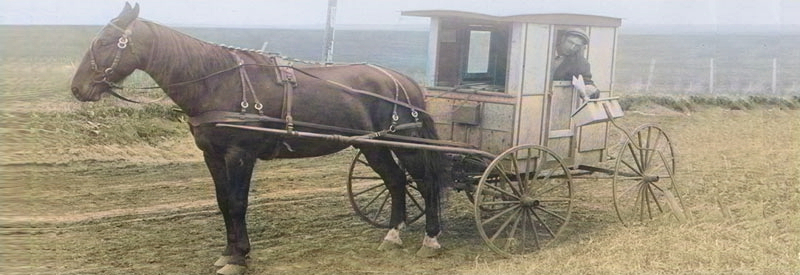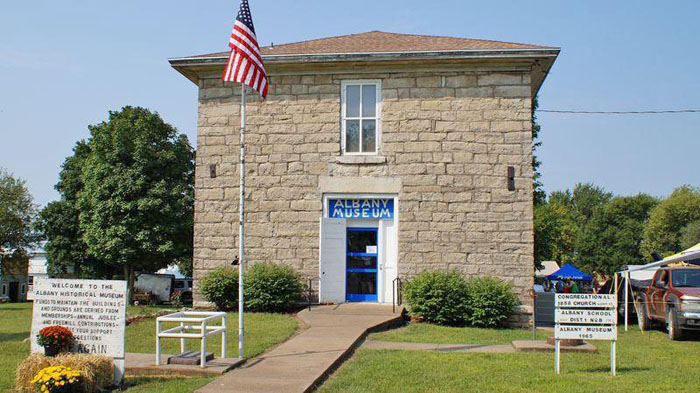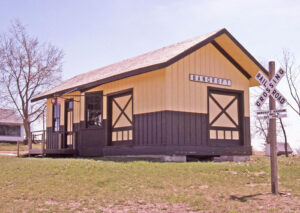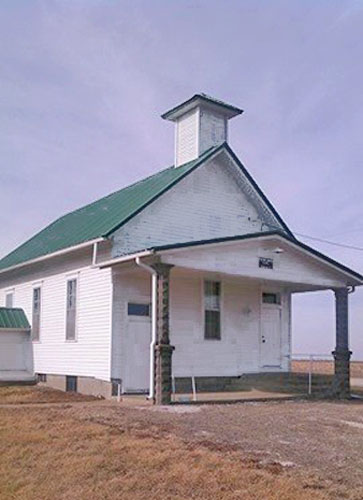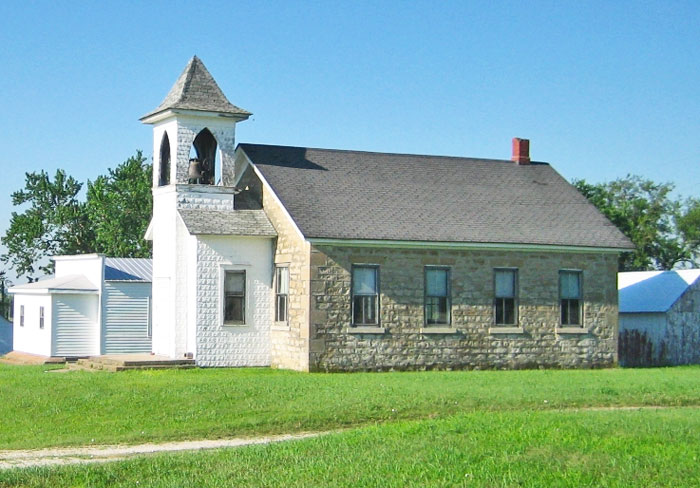Several settlements in Nemaha County, Kansas, were colonized by Easterners motivated by free-state sentiments. The Pony Express, Central Overland California & Pike’s Peak Express, and the Overland Stage Route operated in the county between 1859 and 1870. Portions of the Oregon and California Trails also passed through the county
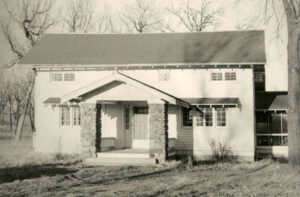
Log Creek Pony Express Station.
More Extinct Towns
| Town | Post Office Dates | Additional Information |
| Albany | 1858-1882 |
Albany was established in 1857 on Elwood and Marysville Territorial Road. It was first populated by families from Castle Creek and Painted Post, New York, who named it after the capital of their native state. |
| America | 1858-1859 | |
| America City | 1860-1932 | This place was established on the Parallel Road from Atchison, Kansas, to Denver, Colorado, on the Red Vermillion River in Red Vermillion Township. On February 14, 1857, the Territorial Legislature approved an act incorporating the town comprising 380 acres of land. Samuel Dickson opened a store in 1857. The town was laid out on June 10, 1858, by Samuel Dickson, president of the town company. Most of the early settlers came from Galesburg, Illinois. A post office was established on June 12, 1860, with George Randel as postmaster. In 1861, a Methodist Church building was erected, and the United Brethren Church was established soon after. A schoolhouse was also erected. In 1862, Jacob Jacobia, a freighter on the Plains, drove a hack on the Atchison/Louisville Post Road. In 1910, it reported a population of 30. The post office closed on December 15, 1932. It was located 20 miles south of Seneca and six miles from Havensville. |
| Ash Point | 1858-1870 | Ash Point was established in 1857 at the center of S8 T2S R11E on the Fort Leavenworth and Fort Laramie Military Road. This place was also called Laramie Creek Station, Frogtown, and Hickory Point. Residents in the immediate area were Josiah Blancett and John Short. A post office opened on November 4, 1858, with Horace Bemus as postmaster. John O’Laughlin, an important man in town, established “Uncle John’s Grocery” and a hotel. On the banks of Vermillion Creek was the site of a Pony Express Station on the California Trail before 1860. Later, it was a stage station on the Overland Stage Route. O’laughlin managed the station operations and was said to have sold whiskey to stage passengers. His building, along with a few area dwellings, constituted the town. Primarily settled by pro-slavery advocates, the community lost favor when Kansas looked as if it would become a Free State. The town continued to serve as a stage stop in the 1860s, but its post office closed on April 18, 1870, and was moved to Clear Creek. Afterward, the town faded, and the townsite later became a farm. |
| Bancroft | 1891-1941 |
Bancroft was located in Wetmore township on the Missouri Pacific Railroad. A post office was established on March 9, 1891. In 1910, it had banking facilities, express and telegraph offices, a post office with one rural route, and a population of 125. The post office closed on May 31, 1941. This tiny town still has a small museum located in its old depot. It was located 19 miles southeast of Seneca. |
| Berwick | 1887-1937 |
Berwick was a little station on the Chicago and Rock Island Railroad. A post office was established on December 5, 1887. In 1910, it had telegraph and express offices, a money order post office, and a population of 31. The post office closed on January 15, 1937. An old one-room school still sits near the old village. It was located 18 miles northeast of Seneca and three miles from Sabetha. |
| Brough/Hayes | 1877-1880 | This town was first called Hayes when a post office was established on August 17, 1877. Its name was changed to Brough on August 28, 1878. The post office closed on April 28, 1880. |
| Capioma | 1857-1906 | Capioma was established in 1856 at the center of S23 T3S R14E, on the Fort Leavenworth and Fort Laramie Military Road. It was named for a Kickapoo Indian chief. The town was platted in 1957, and a post office opened on June 5, 1857, with David Magill as postmaster. A school building was put up the same year. A hotel was opened by Walter Gage in 1859. It was used as a residence as late as 1916. In 1865, William Robinson established a sawmill and blacksmith shop. The post office closed its doors on July 16, 1906. In 1910, its population was 45, and it received its mail from Sabetha. It was located 15 miles southeast of Seneca and nine miles south of Sabetha. |
| Central City | 1858-1863 | Central City was laid out in 1855 by William Dodge southeast of Baker’s Ford. |
| Clear Creek | 1858-1860 1870-1890 |
The post office moved from Ash Point to Clear Creek on June 30, 1858. It was located in a farmhouse in Clear Creek Township. The post office closed on September 21, 1860. However, it reopened on April 18, 1870, and continued for two decades before it closed its doors for the last time on December 31, 1899. |
| Deanville | 1871 | Deanville was North of Sother. The post office was only open for two months. |
| Dorcas | 1877-1882 | Dorcas was a post office in a farmhouse near Capioma. It opened on August 20, 1877, and closed on October 27, 1882. |
| Farmington | NA | Farmington was established in about 1856, about a mile southwest of Baker’s Ford on the St. Joseph and California Road. It embraced the northwest quarter of Section 26 and the northeast quarter of Section 27, Town 1, Range 12, southwest of old Urbana. The town plat was certified on August 23, 1858, by Barney H. York, the president of the town company. Thomas Smith and James Parsons succeeded W. W. Moon at the point where there was a store building, while Rosalvin C. Perham and John E. Perley directed their energies to the building up Farmington. They erected a hotel, store building, and blacksmith shop. The blacksmith shop remained in operation for several years. By the early 1880s, the town had become a pasture. It was located six miles north of Seneca, where the California Trail from St. Joseph crossed the Nemaha River. |
| Fidelity | 1890-1902 | |
| Granada/Pleasant Spring | 1856-1906 | The small hamlet of Pleasant Spring was located in Granada Township. It was on the Central Overland California and Pike’s Peak Express and the Overland Stage Route between 1859 and 1863. On September 19, 1864, the post office name was changed to Granada. |
| Kelly | 1888-1988 | Kelly started when the Kansas City, Wichita, and Northwestern Railway was built through the area. A post office was established on June 9, 1888. By 1910, the railroad was operated by the Missouri Pacific Railroad. At that time, the town had banking facilities, telegraph and express offices, a money order office, and a population of 250. In 1901, St. Bede’s Parish in Kelly, Kansas was organized. The next year, a wood frame church was built. Unfortunately, it burned to the ground in 1913. Bigger plans were made for the second church. The German Gothic-inspired limestone building was completed in 1915. Today, the beautiful structure, with its 125-foot spire, is visible for several miles. It continues to serve a congregation today. Kelly’s post office closed on November 26, 1988. In addition to the church, there are a few scattered homes in the area. Kelly is located in Harrison Township, nine miles southeast of Seneca. |
| Lexington | NA | Situated on the Lane Trail, Lexington was a stop on the Underground Railroad that came through the eastern part of the county. It was located three miles south of the present town of Sabetha. |
| Lincoln | 1861-1868 | Lincoln was established in 1860 J.E. Hocker at the South Fork of the Nemaha River crossing at the mouth of Illinois Creek. J.E. Hocker filed a plat for the community in November 1860. It was named for Abraham Lincoln. A post office was established on March 19, 1861, with Luther B. Jones as the postmaster. At its peak it had two stores, a sawmill, and a blacksmith shop. Because pro-slavery advocates primarily settled it, it lost favor and declined. Its post office closed on September 18, 1868. |
| Log Chain | 1864-1868 | Log Chain, Kansas, was established in Nemaha County in 1860 as a Pony Express Station. |
| Neuchatel | 1864-1901 |
Neuchatel was the name given to a post office in Neuchatel Township. The settlers in the immediate vicinity are French and Swiss. A meeting regarding the building of a schoolhouse was held in March 1863. In May 1863, School District 14 was organized, and James Cooper was hired to teach a three-month term of school commencing the end of June. The school was first taught in a private home. In the fall, a log schoolhouse was built. A post office opened on August 8, 1864. In 1870, Jules Leroux commenced the publication in this township of the Star of Kansas, an eight-page monthly printed in French and devoted to Communism. In 1871, the school district changed to No. 5, serving Nemaha and Pottawatomie Counties, and a new stone structure was built. In May 1876, Jules Leroux moved to Fremont County, Iowa, taking his establishment with him. The post office closed on May 15, 1901. However, the school remained open for another 50 years. It still stands today along with Neuchatel village hall. The community was located in the extreme southwest corner of the county, four miles from Onaga in Pottawatomie County. |
| Pacific City | NA | Pacific City was established in 1856 at the center of Section 14, Town 3, Range 13. A good well on a high hill inspired Orrin Gage to build a hotel. It was once a place of high expectations. Primarily settled by pro-slavery advocates, the community lost favor when Kansas looked as if it would become a Free State. The settlement didn’t make it and soon became a farm. Gage’s hotel was torn down in 1902. |
| Plymouth | NA | Plymouth started in September 1856 when James Redpath and 300 free state settlers joined Preston B. Plumb and approximately 30 men at this point in September 1856. It was located on Lane’s Trail in the southeast corner of S15 T13 R15E, on Pony Creek, six miles northeast of present-day Sabetha. |
| Powhatan | 1857-1867 | Powhatan was established in 1856 at the center of S32 T5S R15E, about three miles northeast of Wetmore. A post office was established on July 17, 1857, with Russell Newell as postmaster. The post office was closed and relocated to Wetmore on December 18, 1867. Twenty years later, in 1887, another town with the same name was established about ten miles to the northeast when the Rock Island Railroad was constructed. A road connected Kennekuk and Powhattan along the south edge of the Kickapoo Reserve. |
| Price | 1895-1906 | Located four miles west of Sabetha, a post office opened in Price on July 15, 1895. It never grew very large. It was a station on the St. Joseph & Grand Island Railroad. The post office closed on August 13, 1906. In 1910, it had a population of just 30. |
| Richmond | 1855-1859 | Richmond, Kansas, in Nemaha County, was settled in 1854 by Cyrus Dolman. It was located on the Fort Leavenworth-Fort Kearny Military Road at the crossing of the South Fork of the Nemaha River. |
| St. Benedict | 1883-1902 | St. Benedict was an unincorporated community in Nemaha County, Kansas. A post office opened on September 10, 1883. The beautiful St. Mary’s Church was built in 1893. The post office closed on December 31, 1902. The church still provides services today, and several homes remain in the area. It is located three miles north of Seneca. |
| Silver Spring | 1872-1875 | |
| Sother | 1871-1878 | Souther was, for a time, the terminus of the Central Branch Railroad. A section house was built, and J. R. Pickett opened a store. It was named for Honorable Thomas Sother and was about four miles northwest of Wetmore. |
| Swift | 1890-1895 | |
| Swifton | 1896-1898 | |
| Taylor-Baker’s Ford | 1885-1890 | Most of the early recorded history of Nemaha County centers around Baker’s Ford, located on the California Trail at the crossing of the Nemaha River. Later, the site became home to a village called Taylor’s Rapids. When a post office was established in 1885, it was called Taylor. |
| Tyler’s | 1864-?? | Tyler’s was established in about 1860. It was located at the crossing of Grasshopper Creek two miles southwest of present-day Fairview. A post office opened in 1864 with John Tyler as postmaster. |
| Urbana/Moorestown | 1855 | Also referred to as Moorestown, the settlement was started in 1854 by W.W. Moon at Baker’s Ford on the South Fork of the Nemaha River. A post office was established on March 3, 1855, with John Jett as postmaster. W. W. Moore and Walter Beeles built a toll bridge and felled a large tree at the Ford to force the use of their bridge. High water carried the tree downstream and destroyed their bridge. The post office was only in operation for a few months. It closed on June 19, 1855. One historian later wrote of Urbana: “Though it was a settlement, it hardly deserved a distinguishing name, except as it was near the center of immediately subsequent settlements.” |
| Wheatland | NA | A paper town located at the geographical center of the county. |
| Woodlawn | 1881-1906 | During the summer of 1881, W. L. Challis selected a fine, natural site in Capioma Township. He then erected a four-story mill with a stone basement, in which he placed a 100-horsepower engine and four sets of burrs. This mill, placed in charge of J. W. Burt as manager, became so popular that a settlement grew up around it. A store building was erected, in which W. N. Taylor placed a stock of general merchandise. A post office was established with Paul Challis as postmaster on May 3, 1881. It was also used as a government office. Dr. J. B. West opened a drug store, and a hotel with nine rooms was available to the traveling public by Albert Yost. The second floor of Taylor’s Store Building was fitted with a public auditorium called Woodlawn Hall. The post office closed on July 16, 1906. It was located about an equal distance from Wetmore and from Sabetha. |
©Kathy Alexander/Legends of Kansas, updated November 2024.
Also See:
Sources:
Blackmar, Frank W.; Kansas: A Cyclopedia of State History, Vol I; Standard Publishing Company, Chicago, IL 1912.
Cutler, William G; History of Kansas; A. T. Andreas, Chicago, IL, 1883.
Kansas Post Office History
Kansas Heritage
Seneca Courier-Democrat
Werner, Morris W.; Pioneer Trails from U.S. Land Surveys

